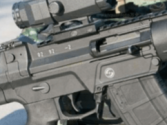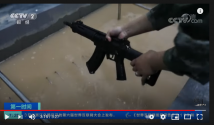I'm kinda curious how QBZ-191 will handle mud. The cutout for the cocking handle seems to be a pretty obvious ingress point for the mud that might jam the gun.
You are using an out of date browser. It may not display this or other websites correctly.
You should upgrade or use an alternative browser.
You should upgrade or use an alternative browser.
QBZ-191 service rifle family
- Thread starter Blitzo
- Start date
TerraN_EmpirE
Tyrant King
But not that great of one. Because bolt carrier is part of the moving parts list on the rifle it’s generally not a great dust cover.The long bolt carrier works as cover
View attachment 67687
The slot does allow entry which would be a trouble spot in letting debris into the receiver.
Don’t get me wrong I am not saying this is a jam every time Gun. That normally requires other aspects to be flawed like timing based off propellant or gas operation issues. Like what happened to M16 in the early Versions when the US Army Ordinance board switched from Stick powder to ball.
Based purely on what we know of it I would say average at best. As there are other rifles in service around the world with similar issues. Basically I wouldn’t suggest taking it in a mud bath.
But not that great of one. Because bolt carrier is part of the moving parts list on the rifle it’s generally not a great dust cover.
The slot does allow entry which would be a trouble spot in letting debris into the receiver.
Don’t get me wrong I am not saying this is a jam every time Gun. That normally requires other aspects to be flawed like timing based off propellant or gas operation issues. Like what happened to M16 in the early Versions when the US Army Ordinance board switched from Stick powder to ball.
Based purely on what we know of it I would say average at best. As there are other rifles in service around the world with similar issues. Basically I wouldn’t suggest taking it in a mud bath.
I'm kinda curious how QBZ-191 will handle mud. The cutout for the cocking handle seems to be a pretty obvious ingress point for the mud that might jam the gun.
Mud bath seems sensational as a test of the weapon's reliability, but its practicality to actually test how reliable a weapon is should be seriously questioned. A weapon that fails a mud bath, still only is a weapon that failed the mud bath. It may be reliable under most of the combat environments. Similarly, just because a weapon can still fire a few shots after you smear mud on it, does not speak much about its overall reliability. Mud bath is simply a particular, and extreme context to test a weapon's reliability.
If memory serves me correctly, AKs, SKSs, X95s, AR-15(M4s) all jam up within 1-5 shots after you put it in mud (if you do not leave the dust cover closed), which suggest to me that conditions that is represented by a mud test is not frequently encountered so these weapons are not really designed to be fired when you put so much mud on it.
Thus, I'd like to be cautious when a single metric (like mud test) is used to make a generalizing and representative conclusion about a weapon's performance in a domain that is clearly more nuanced than a single context/condition/test.
When it comes to QBZ-191, yes it probably will fail the must test just like most guns, maybe even more so since it does not even have a dust cover. But the implication of this failure does not automatically mean the design of its bolt is unreliable.
TerraN_EmpirE
Tyrant King
This is what I mean by mud bath.Mud bath seems sensational as a test of the weapon's reliability, but its practicality to actually test how reliable a weapon is should be seriously questioned. A weapon that fails a mud bath, still only is a weapon that failed the mud bath. It may be reliable under most of the combat environments. Similarly, just because a weapon can still fire a few shots after you smear mud on it, does not speak much about its overall reliability. Mud bath is simply a particular, and extreme context to test a weapon's reliability.
AK failed.
What you showed was a barrel obstruction where in Water was still in the battle and any rifle unless the barrel is extremely heavy overbuilt will fail in that.
HK barrels are exceptionally heavy.
Now then was I generalizing. I admit that. I am pretty sure anyone reading my post should have assessed that it is a guess.
Self loaded gas operated weapons are pneumatic plumbing connected to precision machines moving parts. Debris like mud or dust in those parts pushes the mechanism out of its predescribed specifications. The more exposed parts of the system the more the possible entry of debris into the system.
The AR system tolerances and closures around its parts IE Dust cover make it very much an enclosure operation where the AK dust cover is its charging handle, it upper cover is known for gaps and the weapons bolt is more or less exposed.
The slot like the QBZ191 charging Handle and the BCG side may seem innocuous however those have caused issues on other rifles.
It’s a question really of how acceptable that is to the rifles user IE the PLA. Since QBZ03,QBZ95 and earlier as well export weapons have similar openings they see it as acceptable. Many others do as well as the openings seen are common on a number of weapons in and out of NATO.
With some
Proper care the issues caused on such a mud bath or dust can be remedied.
Yes, that's the one. That's more impressive than a mud test, since the much smaller sediment particles can spread much farther in the gun's internals.Are you referring to this one:
View attachment 67701If so, according to the reporter, the water test is conducted in river water like that of the Yangzi and Yellow Rivers, not mud.
TerraN_EmpirE
Tyrant King
@ZeEa5KPul
They can spread but not cake. Both are potential situations for users to encounter. However in the finer sedentary water the material is fine enough that in all likelihood they would exit the weapon with the water. The only major problem being solved by dumping the barrel out. The small amount of sediment still in the weapon not being dense enough to interfere with the weapon in a major way.
This is akin to HK’s demonstration earlier.
By contrast thick mud clay and pebbles can work its way into the receiver and either dry forming dense blockages or leave pebbles and inclusions in the fine works like the locking surfaces, springs trigger components requiring strip and cleaning.
They can spread but not cake. Both are potential situations for users to encounter. However in the finer sedentary water the material is fine enough that in all likelihood they would exit the weapon with the water. The only major problem being solved by dumping the barrel out. The small amount of sediment still in the weapon not being dense enough to interfere with the weapon in a major way.
This is akin to HK’s demonstration earlier.
By contrast thick mud clay and pebbles can work its way into the receiver and either dry forming dense blockages or leave pebbles and inclusions in the fine works like the locking surfaces, springs trigger components requiring strip and cleaning.
This is what I had in mind since that video is what prompted my comment. I understand that's not a true "mud test", but as I mentioned later I don't believe mud tests have much merit.This is akin to HK’s demonstration earlier.
I don't think any gun can function under those conditions without being stripped and cleaned. The video you linked showed the gun firing immediately after exposure to mud, so the drying and caking you mentioned didn't have a chance to occur. I suspect that if he fired the gun an hour after he took it out of the mud bath and left it in the sun, the result would have been very different.By contrast thick mud clay and pebbles can work its way into the receiver and either dry forming dense blockages or leave pebbles and inclusions in the fine works like the locking surfaces, springs trigger components requiring strip and cleaning.
As for the QBZ-191 specifically, as @Kejora pointed out the bolt carrier seals the gun's internals from the elements when it's closed. As for the charging handle groove, we have no indication that it exposes the gun's internals; I would find it surprising if it didn't form a seal along with the remainder of the bolt carrier.
The more I learn about this "mud test", the more convinced I am that it's a contrivance.


